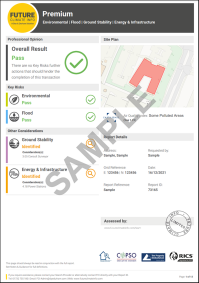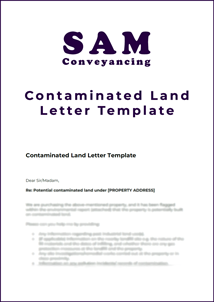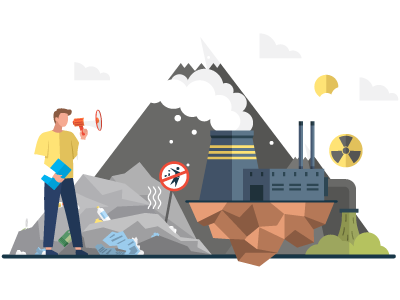Buying a Property on Contaminated Land
- Your local authority search and environmental report flag potentially contaminated land under or near your property.
- Some lenders won't offer a mortgage where contaminated land is present.
- Remediation liability lies with the party who caused the contamination in the first place or, if they can't be located, with the current owners.
- Your solicitor must obtain clarification from the council confirming if there is contaminated land.
Your local authority search and environmental report flags if there is any potential risk of contaminated land under or near your property. In the majority of cases, the contaminated land data isn't up to date, and the contaminated land has been treated/remedied; however, your solicitor needs to investigate if this is the case.
What is a failed environmental search?
A failed environmental search means the property is at risk of being affected by contaminated land, radon gas, flooding, subsidence or energy and infrastructure factors. This conveyancing search only flags the potential risk and suggests you investigate further, but how does this affect your purchase? Is buying a house on contaminated land, for example, a good idea?
Do you need an environmental search when buying a house?
If you're buying using a mortgage, your lender will most likely require you to get an environmental search. This is because any potential risk to the property is likely to affect your ability to get a mortgage. If you haven't ordered your environmental search yet, use the form below:
|  |
Is contaminated land a problem?
The term contaminated land is generally used to describe land polluted by heavy metals, eg arsenic, cadmium and lead, oils and tars, chemical substances and preparations, eg solvents, gases, asbestos or radioactive substances.
From a legal perspective, contaminated land is defined as where substances could cause:
- significant harm to people or protected species; and/or
- significant pollution of surface waters or groundwater.
This definition refers to contamination caused by past uses of sites such as former factories, mines, steelwork, refineries or landfills.
Can you get a mortgage on contaminated land?
You can still get a mortgage when buying a property on contaminated land. Your mortgage lender has set criteria for matters they require to be reported to them, and contaminated land is one of them. In the mortgage lender's handbook, it states:
"5.4.4 You (the buyer's solicitor) must advise us of any contaminated land entries revealed in the local authority search. Check part 2 to see if we want to receive environmental or contaminated land reports (as opposed to contaminated land entries revealed in the local authority search). If we do not, you do not need to make these enquiries on our behalf."
Part 2 is the specific lender's position, which varies by lender. For example:
Nationwide Building Society | We do not require environmental or ancillary reports (e.g. flooding, contamination, and energy and infrastructure reports) that you have requested for the borrower, even if adverse information is revealed, provided the borrower is aware and you have advised them that full disclosure must be made to the insurer prior to completion and they must obtain insurance under normal terms. |
The above positions can change so you can check the up-to-date position here - UK Finance lenders' handbook.
How do you find out if your land is contaminated?
If there is a risk, it gets flagged in the environmental search report. As part of the conveyancing process when buying a house, you order conveyancing searches on your property. Lenders will usually require you to get an Environmental Search.
An Environmental Search is a report including information about flooding, radon, ground stability, energy and infrastructure and contaminated land. Information about contaminated land may also appear within your local authority search.
What happens if land is contaminated?
If your report shows a risk, then you must seek further advice from your solicitor and look to find out from the council whether the land your property is built on actually is affected by contamination.
In the majority of cases, the Environmental Search will show no risk; however, you’ll need to do more investigations if the environmental report states the following:
"Our environmental consultants have identified a significant risk of contaminated land within the vicinity of the property."
You can write to the Environmental Health Department at the Local Authority or to the Environment Agency. You want to find out if the information in the Environmental Report is current or if the contaminated land has been remedied.
Confirm if Your Property is Built on Contaminated Land
Download our letter and email it to your local authority to get confirmation for your lender on whether the property is contaminated.
- Instant download.
- Easy to fill in.
- Sign and send to your Local Authority.
The templates will be attached to your confirmation email after payment.
Please allow a couple of minutes for the email to arrive.

£4.99 INC VAT
Asking them to confirm if the information in your environmental report is still valid will be free of charge, as it's considered a basic enquiry. A further analysis might, however, incur a cost.
Who has liability for contaminated land?
If the land is contaminated, the local authority serves 'notice of remediation' to the party responsible for it's cause. Whether contamination was caused knowingly or unknowingly, they will still be responsible for cleaning it.
If you buy a property and the previous owner, who was responsible for the contamination, can no longer be found, you will become liable. It is essential to find out if the property is on contaminated land and whether you are at risk of becoming liable for an expensive clean-up operation.
Can I buy a property on contaminated land?
You can still purchase as long as the lender is willing to offer you a mortgage. As a cash buyer, you must still be aware of the risks, as these contaminants could cause significant harm.
Your solicitor should advise you on this matter, and you can also look at the following options:
- Write to the Environmental Health Department.
- Obtain a copy of the Building Warranty Certificate (NHBC) from the sellers.
- Contact the Planning Department at the local authority.
- Get Residential Contaminated Land Indemnity Insurance Policy.
Does NHBC cover contaminated land?
An NHBC Certificate or Cover Note will provide insurance against contaminated land, as long as they're dated after 1st April 1999, and the policy includes property with contaminated land cover. If the warranty provider is Zurich/Premier/LABC, then as long as the policy schedule shows contaminated land or environmental impairment cover is included, this will be fine as well.
- Planning permissions for the site include conditions associated with contaminated land.
- Written confirmation from the local authority that any relevant conditions have been fully discharged.
Contaminated Land Indemnity Insurance Policy
Indemnity insurance is a relatively simple solution which should satisfy your lender. Your conveyancing solicitor will provide a contaminated land indemnity insurance quote and advise on its suitability.
If you take out this insurance, it can protect against the losses for complying with a remediation notice. The cost of the policy can vary from £180 upwards, so it is cheaper to go to the council first to check their records. If they can confirm that there is no longer contamination at the property, you won't need to get insurance.
How do you treat contaminated land?
Bioremediation
This process uses bacteria or fungi, which use the contaminant as a food source, so it is widely used to remediate organic contaminants, such as:
- hydrocarbons
- halogenated organic solvents
- halogenated organic compounds
- non-chlorinated pesticides and herbicides
- nitrogen compounds
- metals (lead, mercury, chromium)
- radionuclides
Bioremediation is often relatively affordable but may take several months.
Chemical oxidation
Reactive chemical oxidants are injected into the soil and groundwater to destroy the contaminant rapidly and completely. It works well on organic contaminants, including:
- TPH
- BTEX
- PCBs
Soil stabilisation
This method locks contaminants in the soil, either by modifying the contaminant into a less dangerous form or by binding the contaminant in place so that it can't cause harm.
It is more suitable for construction as it makes the soil more resistant and less permeable.
Physical methods
Soil washing uses a liquid wash solution to wash away contaminants and fine-grained soils such as silts and clays, leaving clean coarse-grained soils such as sand and gravel. The contaminated fine-grained soils must be disposed of at a licenced facility.
Andrew started his career in 2000 working within conveyancing solicitor firms and grew hands-on knowledge of a wide variety of conveyancing challenges and solutions. After helping in excess of 50,000 clients in his career, he uses all this experience within his article writing for SAM, mainstream media and his self published book How to Buy a House Without Killing Anyone.
Caragh is an excellent writer and copy editor of books, news articles and editorials. She has written extensively for SAM for a variety of conveyancing, survey, property law and mortgage-related articles.









